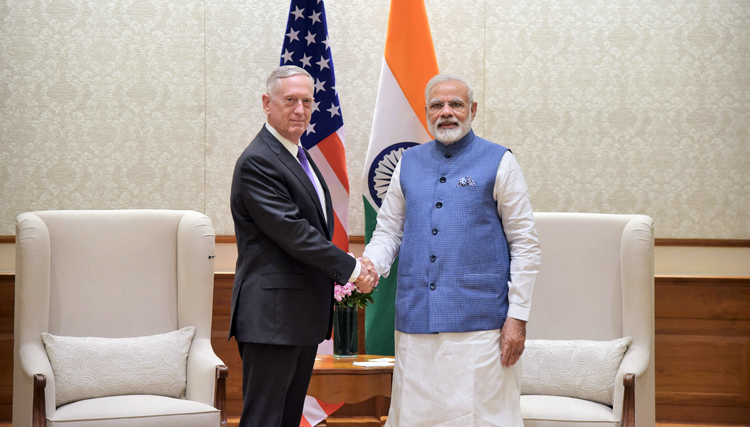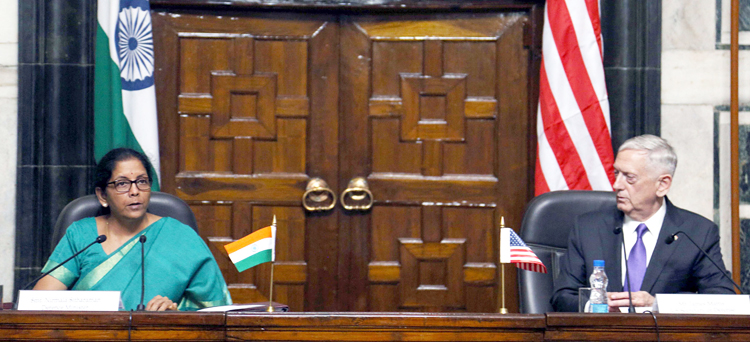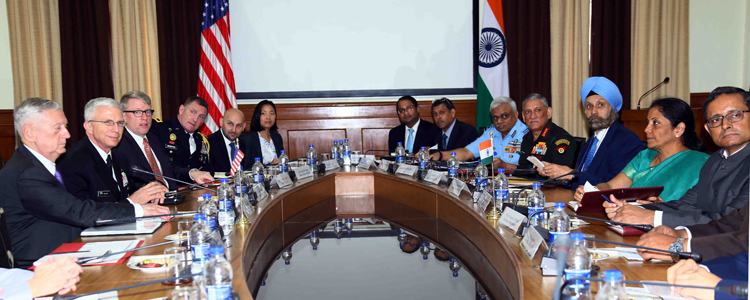INDIAN ARMED FORCES CHIEFS ON OUR RELENTLESS AND FOCUSED PUBLISHING EFFORTS

SP Guide Publications puts forth a well compiled articulation of issues, pursuits and accomplishments of the Indian Army, over the years

"Over the past 60 years, the growth of SP Guide Publications has mirrored the rising stature of Indian Navy. Its well-researched and informative magazines on Defence and Aerospace sector have served to shape an educated opinion of our military personnel, policy makers and the public alike. I wish SP's Publication team continued success, fair winds and following seas in all future endeavour!"

Since, its inception in 1964, SP Guide Publications has consistently demonstrated commitment to high-quality journalism in the aerospace and defence sectors, earning a well-deserved reputation as Asia's largest media house in this domain. I wish SP Guide Publications continued success in its pursuit of excellence.
- Indian Air Force Aims for Full Indigenous Inventory by 2047 — Air Chief Marshal A.P. Singh
- Rajnath Singh assumes charge as Defence Minister for the second consecutive term
- Interim Defence Budget 2024-25 — An Analysis
- Union Defence budget 2024
- Prime Minister Modi Flies in the LCA Tejas
- New Chapter in India-Italy Defence Ties
- Airpower beyond Boundaries
India–US: New Phase in Defence Partnership

After India-US defence relations reached to its astounding heights at the fag end of Obama administration, both the countries saw a lull in high level contacts creating a perception that the new Trump administration believes more on transactional relationship than sharing something critical to India's defence needs. The Trump administration could afford to send its Defense Secretary to India only after completing eight months in the first year of its four year tenure. Nonetheless, this long overdue visit of the US Defense Secretary James Mattis is expected to revitalise and give a new push to the India-US Strategic and Defence partnership, especially in view of the new Afghan strategy of the Trump administration , which is much closer to India's hearts.
Though after the 26th September talks in the South Block at Raisina Hills, Indian defence minister Nirmala Sitharaman bluntly refused to agree to the wishes of the Trump administration to contribute more in terms of strengthening security in the violence ridden country, the two sides discussed how to mutually assist the democratically elected government of Afghanistan, which is an anathema to the Taliban and Pakistan. Mattis did not press for Indian troops presence in Afghanistan as the US side perhaps recognises the sensitivities of the Indian government to ask its troops to land on the thorny grounds of Afghanistan.

With convergence of views on Afghanistan, Indian Ocean and the Indo-Pacific region, it was natural for the US side to agree to the Indian needs of cutting edge defence technologies, which will ultimately balance the main rival of United States. As China is trying to restrict the strategic space for the only super power i.e. US from the Indian Ocean to Pacific Ocean, the United States, during Obama administration found it incumbent on them to grant India the status of Major Defence Partner, which will enable the Pentagon to share its top end defence technology with India. With this view, the US side had also entered into a specific agreement called the Defence Technology and Trade Initiative ( DTTI) .
Nirmala Sitharaman disclosed that during the talks with James Mattis, both sides discussed how to refocus and re-energize the DTTI as a mechanism to promote technology sharing as well as co-development and co-production efforts. Under the DTTI umbrella the US side expressed their willingness to share cutting edge platforms, which would enhance India's defence preparedness to meet current and emerging threats. Since there has been concerns in Indian side regarding the fate of the DTTI , this issue was discussed during the Mattis – Nirmala meeting. Though, Indian concerns were addressed to a large extent when the Trump administration cleared the National Defence Authorisation Act of 2017 ( NDAA 2017) , which institutionalised the DTTI mechanism.
Under the DTTI , both sides have nominated DRDO and US defence laboratories as lead agencies to fructify the selected projects and plan joint work on other futuristic projects. Under the DTTI, the two sides are discussing the development of Next Generation Individual Protection Ensemble, Mobile Electric Hybrid Power Source, Digital Helmet Mounted Display and the Joint Biological Tactical Detection System. The first two projects have reached the agreement stage whereas the last two are in discussion stage. These four projects under DTTI were announced during President Barak Obama visit to India as Chief Guest for the 2015 Republic Day parade.

These projects under DTTI were decided during the Obama regime. Under the Trump administration the two sides are still waiting for the next round of DTTI meeting planned to be held in Pentagon. Under the DTTI, the US side had proposed bilateral development of Future Vertical Lift Helicopter (FVLH). The American side had also proposed to the Indian Ministry of Defence that the two sides work on an agreement for US made fighter F-16 or F-18 under DTTI but Indian side declined the offer. However, since the IAF has invited Lockheed Martin along with SAAB of Sweden for their single engine fighters, the US Defense Secretary is believed to have raised this issue with Nirmala.
According to reports, the US side is still pressing Indian leaders to accept one of the two US fighters to be made in India for the Indian Air Force. Though, the US arms companies have many concerns regarding the Strategic Partnership policy of making front line fighters for IAF or submarines for Indian Navy in India. The US defence company Lockheed Martin has already written to the Indian defence ministry regarding the concerns relating to majority stake in the joint venture company to be set up in India besides issues relating to technology transfer. Significantly Mattis disclosed that he discussed with Nirmala ways to further deepen the robust Defence Trade and Technologies through the Defence Technologies and Trade Initiative. He emphasized that cooperation in these areas will improve the capabilities of both our militaries and reinforce the foundation for an enduring partnership.
In this context Defence Minister Nirmala said that both agreed on the need to expand on the progress already made by encouraging co-production and co-developmental efforts. Nirmala reiterated India's deep interest in enhancing defence manufacturing in India under Prime Minister's Make in India initiative. She thanked Mattis for his supportive position in this regard and looked forward to working closely with him to realize joint projects.
The US arms majors have tasted the fruits of Indian defence modernization during last one decade with over US$15 billion deals. They are now eyeing over US$200 billion worth of arms acquisition plans during next one and half decades. They cannot afford to miss the Indian armed forces modernization bus. The rival European and Russian defence firms are offering every thing under the sky to win the Indian contract.
To win Indian hearts and minds, Mattis talked of steadily expanding defence cooperation , underpinned by a strategic convergence based on common objectives and goals in the region. In this backdrop Mattis referred to grant of Major Defence Partner to India reflecting the progress made in strengthening our cooperation. According to Mattis, grant of Major Defence Partner status recognizes India as a pillar of regional stability and security. This also reflects our desire for a long-term strategic partnership in the 21st century.
Mattis said that in the wide ranging new relationship, security is one of the key strategic pillars. This will help expand US–India cooperation in building partnerships, across the region. In this context Mattis talked of convergence of views on Afghanistan and lauded India's invaluable contributions to Afghanistan and welcome further efforts to promote Afghanistan's democracy, stability and security. He also assuaged India's concerns on terrorism, without naming Pakistan, by stating that there can be no tolerance of terrorist safe heavens.
Various pronouncements of Mattis after talks with Nirmala Sitharaman gave the impression that the US side is very eager to deepen its maritime partnership with India which will help in balancing and countering China not only in Indian Ocean but also in South China Sea.
In this backdrop, Mattis also talked of India's vital role to play in supporting South East Asia's regional institutions – particularly ASEAN – and building partnership capacity across the region. He also appreciated India's leadership role in the Indian Ocean and both sides seeking to work together to build a regional architecture.
Mattis said that expanding maritime engagement is among his top priorities. The two sides are already holding annual maritime dialogue which according to Mattis is an important mechanism to develop shared understanding of the challenges we face and opportunities for cooperation in addressing them. Mattis referred to US –India annual maritime naval exercise with Japan , which he described as an example of deepening operational cooperation. Satisfied with the visit Sitharaman commented that India and US are entering a new phase in bilateral strategic defence partnership.
(The Writer is a Strategic Analyst)





